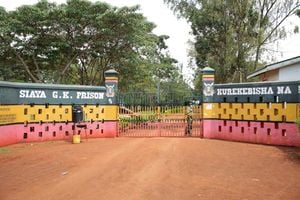Questions arise over demolition of structures on road reserves

Airgate Centre, previously known as Taj Mall, in Nairobi being demolished on September 15, 2018. PHOTO | ANTHONY OMUYA | NATION MEDIA GROUP
What you need to know:
- Kura Director-General Silas Kinoti said that the demolition was necessary, citing serious traffic flow challenges at the junction.
- Outer Ring Road was revamped after the government received a Sh9.8 billion loan from the African Development Bank (AfDB) in 2014.
- Gorasia called on the Directorate of Criminal Investigations to prosecute the individuals who cleared him to put up the business.
As the Nairobi County Government ratchets up the demolition of buildings sitting on road reserves and riparian land, the integrity of the effort is being questioned.
Some Kenyans on social media asked why the Mike Sonko-led administration is demolishing private businesses that are providing employment to the youth.
More importantly, the administration has been criticised for bringing down the structures yet it was the one that approved the construction.
On Saturday, Airgate Centre, formerly known as Taj Mall, in Embakasi was destroyed after Nairobi Regeneration Committee Head of operations Julius Wanjau said the building situated at the junction of Outer Ring Road has encroached on the road reserve hindering its expansion.
Of particular interest to Kenyans is why the Kenya Pipeline Corporation waited until the last minute to condemn the building.
In a statement to newsrooms on Saturday when the bulldozer had already made its way to Airgate Centre, Managing Director Joe Sang said the structure was constructed on top of a pipeline network.
Thus, Mr Sang said, it was a threat not only to tenants but also to residents living in the adjacent areas.
PIPELINE
He said the affected lines are the old Mombasa-Nairobi pipeline (Line 1) and the recently completed Mombasa-Nairobi pipeline (Line 5).
"KPC has already embarked on an exercise to remove all the illegal structures and buildings across the pipeline network. We hereby urge all the persons who have erected illegal structures or settled illegally on our right of way to move out with immediate effect in the interest of safety and security of fuel supply for the country and the region," the statement on Saturday said.
Facebook user Michael Mwendwa expressed his disapproval against the committee's actions. He wrote: "The building was approved, constructed and been in operation for long. A major road had to be diverted because the building was on the way, that would have been the most ideal time to demolish it."
He went on: "From Ngara to town you will realise that Kahama hotel has interfered with the road. The white colonialists were better than the current ones."
Dr Michael Odero, through his Twitter handle @oderomichael, said: "So apparently it'll take Saany 4 weeks to completely takedown Taj/Airgate Mall. Knowing the cost to hire and run such heavy equipment, my question is, who owns Saany? Who has landed this tender from NEMA? In the global practice of demolitions, is this justifiable?’
AFDB LOAN
Additionally, Ory Okolloh Mwangi (@kenyanpundi) wrote: "We overpaid for the road. We will pay for the losses caused by s*** approvals. We will pay to fix the road redesign."
The owner, Mr Rameshchandra Govino Gorasia said he spent Sh5.5 billion on the building that was opened in August 2011, and has lost up to Sh3 billion in rental income.
As the real estate mogul counts his losses, it is equally important for Kenyans to ponder, who is to pay for the redesign of Nairobi’s Outer Ring Road?
The road was revamped after the government received a Sh9.8 billion loan from the African Development Bank (AfDB) in 2014.
Further, the Kenya Urban Roads Authority said in March this year it awarded Chinese firm Sinohydro Tianjin Engineering Limited a Sh880 million tender to put up 11 footbridges along Outer Ring Road.
With this in mind, it would be interesting to know why the government had to redesign the road to accommodate the building.
APPROVAL
The National Land Commission (NLC), which had initially gazetted the two plots that the mall stood on (LR No 7075/13/1, a reserve for Outer Ring Road and private land LR 7075/24), assured the owner that all was well.
"Kenya Urban Roads Authority (Kura) has redesigned the road such that the building would not be affected or demolished," NLC Chairman Muhammad Swazuri said in March 2016.
The road authority also made the same guarantee: "This is to clarify that the current construction of Outer Ring Road will not require Taj Mall to be demolished," the agency, through its managing director Sila Kinoti, wrote to Taj Mall management on November 24, 2014.
Back to the Kenya Pipeline Corporation. Why did it take over seven years to realise such a grave mistake?
INVESTIGATIONS
Why did KPC have to speak about this on the day of the demolition? Whose safety and integrity was it serving?
On Saturday evening, Kura Director-General Silas Kinoti said that the demolition was necessary, citing "serious traffic flow challenges" at the junction.
"In due course, motorists should now expect functional slip roads, service roads, and other necessary facilities to improve movement of traffic," he said.
As the demolition went on, Mr Gorasia called on the Directorate of Criminal Investigations to prosecute the individuals who cleared him to put up the business.
"It is very wrong to demolish this building claiming it is on a road reserve. The good thing is that with land, they are all documented, starting from the title deed, change of user, and all the other approvals; and these documents are all in place," he told journalists.





